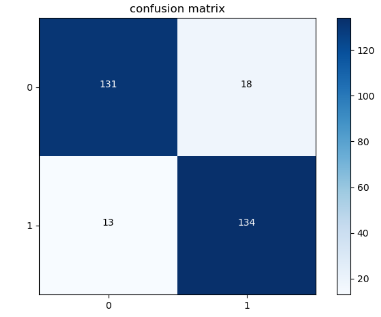1. itertools.product 进行数据的多种组合
intertools.product(range(0, 1), range(0, 1)) 组合的情况[0, 0], [0, 1], [1, 0], [1, 1]
2. confusion_matrix(test_y, pred_y) # 构造混淆矩阵
混淆矩阵是TP(正的预测成正的), FP(正的预测成负的), TN(负的预测成负的), FN(负的预测成正的)

从混淆矩阵中,我们可以很清楚的看出这个信息,这是一个信用欺诈的案例, 134表示的是将欺诈的预测出来的数值, 13表示的是将欺诈的预测成正常的, 131表示的是将正常的预测成正常的,18表示将正常的预测成欺诈的
精度: (134 + 131) / (134+131+13+18)
召回率: (134) / (134 + 13)
F1得分 : (1 / (精度 + 召回率))
代码:使用的是一个下采样的欺诈数据的代码,使用confusion_matrix 获得混合矩阵,然后使用plt.imshow() 进行画图操作
best_c = printing_KFold_score(under_train_x, under_train_y) import itertools # 画出混淆矩阵, 导入confusion_matrix def plot_matrix(conf, classes, title='confusion matrix', cmap=plt.cm.Blues): # 展示直方图 plt.imshow(conf, cmap=cmap) # 图片标题 plt.title(title) # 图片颜色条 plt.colorbar() # 设置x轴和y轴位置 x_index = np.array(classes) # 第一个参数是位置,第二个参数是标签名 plt.xticks(x_index, classes, rotation=0) plt.yticks(x_index, classes) conf_mean = conf.max() / 2 # itertools.product # [0, 1] & [0, 1] # [0, 0], [0, 1], [1, 0], [1, 1] # 将数字添加到混合矩阵中 for i, j in itertools.product(range(conf.shape[0]), range(conf.shape[1])): plt.text(j, i, conf[i, j], horizontalalignment='center', color='white'if conf[i, j] > conf_mean else 'black') # 画出的图更加的紧凑 plt.tight_layout() from sklearn.metrics import confusion_matrix # 建立逻辑回归模型 lr = LogisticRegression(C=best_c, penalty='l1') # 模型训练 lr.fit(under_train_x, under_train_y) # 模型预测 pred_y = lr.predict(under_text_x) # 获得混合矩阵 conf = confusion_matrix(under_test_y, pred_y) # 画图 plot_matrix(conf, classes=[0, 1]) # accrurracy # 精度 accurracy = (conf[0, 0] + conf[1, 1]) / (conf[0, 0] + conf[0, 1] + conf[1, 0] + conf[1, 1]) # 召回率 recall = conf[1, 1] / (conf[1, 0] + conf[1, 1]) # F1得分 F1_score = 1 / (accurracy + recall) plt.show()





